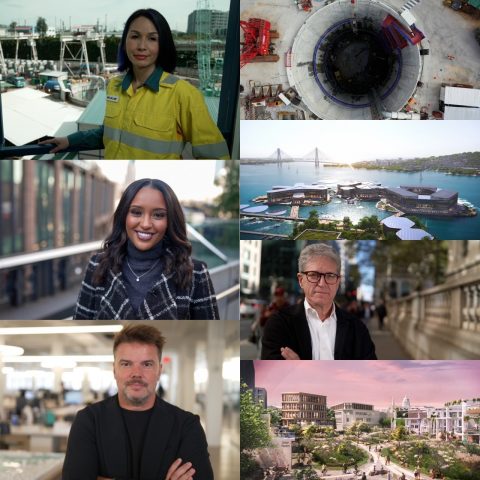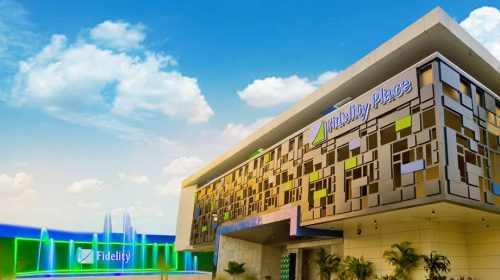The Next Frontier airs on CNN International from Saturday 10th December

In a new series The Next Frontier, CNN’s Rahel Solomon explores the future of living and how the cities of tomorrow are being imagined today.
In the first episode, Solomon examines the topic of ‘How We Will Live’. With populations expected to rise, and most people projected to live in urban areas, CNN meets the architects, designers, and dreamers behind the future way of life. From soaring skyscrapers to subterranean designs, and cities floating on water to urban rewilding, a new world of possibility is already being prepared for.
Oceanix is the first ever floating city, currently being built in Busan, South Korea. Bjarke Ingels, the creative director of BIG, the architects behind Oceanix, explains why climate change has accelerated the need to design floating cities, “In many ways the idea of floating cities has crept up on us over the years. Basically, all coastal cities in the world are facing a new reality.”
Ingels talks about the design potential of floating cities, “The cities are anchored onto the seabed, but they’re flexible. So literally, if something about the city does not work, maybe where you place the school and you want to place it in a different location, you could unplug that platform and move it to a different location, which is something that’s impossible to do on land. So, this means that this city is alive and listens to the needs of the community and responds to them.”
Oceanix’s founder Itai Madamombe believes that floating cities are a solution to teach people to live in harmony with the oceans, “We believe that people living on water is inevitable. Not only is it inevitable, it’s imminent. I mean, think about it, the ocean makes up over 71% of the earth’s surface. So, we are really living on planet ocean, and the ocean offers us so much to meet our needs for shelter, for food, for energy, and for mobility as well.”
Floating cities are just one possibility for the future, another is life among the clouds. Dutch architect Stefan Al says that the next frontier is more sustainable skyscrapers. He tells CNN, “What I think is probably more important than getting taller is getting greener. How can we build more sustainably and how can we be more inclusive with our buildings? In New York for instance, a lot of the tallest buildings are playgrounds for the uber rich, but if you look at the history of skyscrapers, very often they were also seen as examples of social housing, of affordable housing. And I think that’s the legacy of the skyscraper.”
From the clouds, to life underground, subterranean cities are also a possibility for our future lives. In Singapore, a series of tunnels could shape the future of urban planning all over the world. Peter Stones, associate engineer at Arup, leading the Civil Water and Resources team, explains, “The next frontier is how to plan and develop our underground spaces in a way that is sustainable, and takes into account their permanence and longevity, and really delivers on the promise that they provide to enhance liveability in our cities.”
Stones details how different layers of subterranean life are already in action, “Typically, the layers that are shallowest, closest to the surface, are given over to more human centred uses, which is why we see underground pedestrian networks, or underground malls maybe at basement one, and basement two in our cities. And as we go further deeper, typically, we find transport infrastructure such as rail tunnels. So we see an interesting layer cake of the underground space development, where those human centred uses are really prioritised at the shallowest levels, and the deeper levels are reserved for those uses which require less human contact.”
In the future, Stones believes we will see further expansion of underground developments, “Globally as our cities grow in terms of population, in terms of number, in terms of density, that will inevitably push us to use underground space for our transport, and other uses. So, I envisage a future really where the topside is prioritised for people, for ecology, for nature, for plants, and underground space can service that topside through infrastructure and through other uses.”
More space for nature is a recurring theme for urban centres of the future, with green designs already starting to take shape. In Nottingham, England a rewilding project is aiming to bring nature back to the city. Designer Thomas Heatherwick discusses the project, “There’s an opportunity to heal the heart of the city, but also making new green space. And we can use the old structures to bring it alive and not just make any old park but make something really distinctive and unusual and unlike anywhere else in the world.”
Rewilding is beneficial not only for the people who live in a city, but also the planet as a whole, with trees and green spaces absorbing more carbon than they release. Heatherwick hopes that Nottingham will become a blueprint for other cities, “We forget that you can be ambitious, you can be artistic while adapting things rather than destroying them. And you might just not be soulless because you’re borrowing all that history and texture, which is so precious, and everyone values it.”
Keeping pace with the times, while also designing for the future. Whether it’s incorporating nature, floating on water, soaring through the sky, or exploring underground, The Next Frontier explores the ways our cities will evolve in years to come.







Leave a Reply